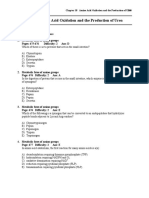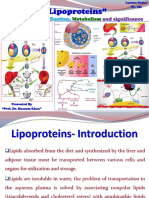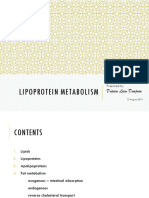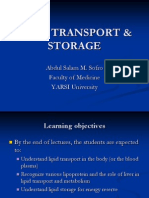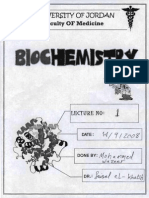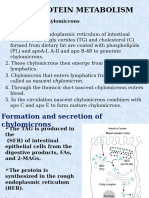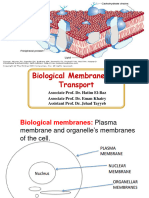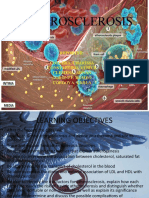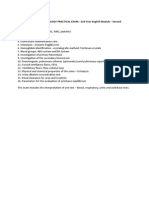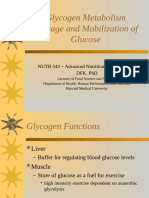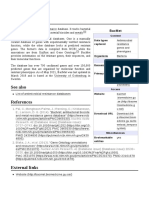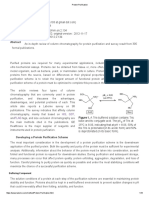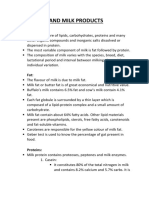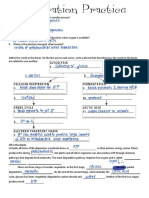Carol Davila Pathophysiology Notes
Carol Davila Pathophysiology Notes
Uploaded by
Giorgos Doukas KaranasiosCopyright:
Available Formats
Carol Davila Pathophysiology Notes
Carol Davila Pathophysiology Notes
Uploaded by
Giorgos Doukas KaranasiosOriginal Description:
Original Title
Copyright
Available Formats
Share this document
Did you find this document useful?
Is this content inappropriate?
Copyright:
Available Formats
Carol Davila Pathophysiology Notes
Carol Davila Pathophysiology Notes
Uploaded by
Giorgos Doukas KaranasiosCopyright:
Available Formats
Any spread of this document will result in death XD
Phathophysiology 8th lecture:
The pathophysiology of lipids metabolism:
Lipocoproteins are formed of a hydrophobic part and a hydrophilic part and they are
spherical in structure.
In the center there is the hydrophobic part and in the exterior there is the hydrophilic
part and this way, the hydrophilic part helps the lipoprotein structure to stay in water
(because the water is the solvent of plasma).
- In the exterior we have phospholipids and we have free cholesterol,
- In the middle of this spherical structure we have cholesteryl esters and also we have
triglycerides .
In this structure we have proteins named apoproteins and usually they have a exterior
hydrophilic portion and a hydropphobic structure in the middle of this structure.
Lipoproteins in plasma, can be seperated by centrifugation or by electrophoresis
because their content is proteins.
And we distinguish lipoproteins density,electrophoresis permeability, the content of
triglycerides, the content of cholesterol, phospholipids and proteins.
The first lipoprotein is chylomicron with a very very low density, with a very small
protein content, thats why these lipoproteins dont migrate in electrophoresis.
They have a very high quantity of triglycerides (85-95% ),
Triglycerides are exogenous or endogenous, exogenous triglycerides originate from
food, while endogenous triglycerides are formed in the liver.
Any spread of this document will result in death XD
Chylomicrons are synthesized by enterocytes from lipids absorbed in the small
intestine.
Next lipoproteins migrating in electrophoresis in bands are pre-beta which are very
low density lipoproteins-VLDL (pre beta lipoproteins).
- These lipopreoteins have a high content of triglycerides (50%), these
triglycerides are from endogenous origin because they are synthetized in the
liver.
- They have also cholesterol around 20% especially esterified cholesterol
- 15-20% phospholipids
- maximum 10% apoproteins.
Apolipoproteins (ALPs) are the protein components located on the surface of
an associated lipoprotein. ALPs affect the functions of the lipoproteins on
which they reside( their functions will be explained later on)
What kind of apoliporoteins do the chylomicrons and the VLDL have?
lipoproteins have?
Chylomicrons have the apo B48, also apo-e/ apo-a/apo-c/apo-a1/apo-a2/ apo
c2/ apo-c3 and so on.
The VLDL have apo b100 which is a very important ligand for the cellular receptors.
The VLDL also contains apo-e/ apo-a1/apo a2/apo-c2/apo-c3.
Apo B48 is synthetized in the enterocytes, its the form of apo-b with low molecular
weight, and apo b100 is synthesized in the hepatic cells, its the form with high
molecular weight.
Also in the liver apo-e is synthesized.
The next lipoproteins is the LDL: LDL migrate in the electrophoresis in the beta
region,
- the LDL have a high content of cholesterol (50%),
- around 20% phospholipids
- very low contenct of triglycerides and higher content of proteins.
Apolipoproteins: LDL have especially apo b-100, this is the most important apo
lipoprotein for LDL. And also sometimes c1,c2,c3 But the most important is
b100.
And the last lipoprotein is HDL: high density lipoprotein migrating in alpha region,
with:
- a low concentration of triglycerides,
- moderate concentration of cholesterol,
- higher concentration of phospholipids
- high concentration of proteins
Apolipopreoteins:Apo-e as a ligand/ apo a1 and a2, c2,c3 and so on.
Any spread of this document will result in death XD
Among these lipoproteins we can find sometimes in the plasma some other
lipoproteins, Lipoprotein A for instance, this is an abnormal lipoprotein with high
density, that migrates in pre beta region.
This apo protein have a sequence in its aminoacid sequence structure similiar to
the plasminogen.
The presence of lipoprotein A will have this effect:
Apo-A with that structure similiar to plasminogen is able to bind to annexin so
will inhibit & will become a competitor for the tissue plasminogen activator ,
so in this way the presence of lipoprotein A will decrease the fibrinolysis and
there will be a predominance of coagulation, and so a tendency to thrombosis.
Another abnormal lipoprotein is the IDL(intermediate density lipoprotein): Migrates
in beta zone but having a very low density lipoprotein .
IDL represents a transitory form of lipoproteins resolving from transformation of
VLDL but they are very quickly taken from the circulation in 2-6 hours by the cellular
receptors because they contain apo-b100 and apo-e, which help them to be rapidly
taken by the cells, because in this combination apo-e increases the speed of binding
and they are bound and transformed, they are catabolized and they disappear rapidly
from blood.
They have a very low time to survive in plasma. But there are pathological situation
in which they cannot be bound and they can not be metabolized, so they persist in
plasma very long. In this way they will be found in the electrophoresis of the
lipoproteins. So these finids are abnormal.
IDL have a high content in triglycerides and cholesterol.
Another important lipoprotein(pathological lipoprotein), is the lipoprotein X:
- present in cholecstasis syndrome
- having a high content of free cholesterol and phospholipids.
- This lipoprotein X migrates after B zone.
apo proteins have 3 important functions:
1. They help the lipids to be transported in plasma forming the lipoproteins,
because lipids cannot be dissolved in plasma .
2. Some apoproteins are important co-factors for some enzymes involved in the
metabolism of lipids. For instance:
- Apo-a1 is a co-factor for lecitin cholesterol acyltransferase, which is involved
in the esterification of the plasma cholesterol.
- Apo-c1 also have such an effect but a bit weaker as a1.
- Apo-a2 has an important effect,it's a co-factor for hepatic lipase
- Apo-c2 is a co-factor for endothelial lipoprotein lipase .
- Apo-c3 having an inhibitory ability for endothelial lipoprotein lipase, limiting
the effect of lipoprotein lipase, endothelial lipoprotein lipase.
So these apo-proteins, in the structure of lipoproteins can help in the
metabolization of the lipids from the lipoproteins.
3. Other functions of lipoproteins, is that of B-ligands for the cellular receptors,
for instans apo-proteins B .
We have 2 sort of apo-B: apo-b48 ( low molecular weight, synthetized by
enterocytes ) and apo-b100 ( high molecular weight ,synthetized by the liver.)
These apo-b are important ligands for the cellular receptors.because of these
Any spread of this document will result in death XD
apo-B the chylomicrons and the VLDL can be taken by the hepatic cells and
also by the endothelial cell and binding the chylomicrons or VLDL to for
example endothelial cells then the endothelial lipoprotein lipase can
hydrolyze the triglycerides from this lipoproteins.
And from triglycerides will resolve fatty acides and glycerolsThese fatty
acids and glycerol can go back to the circulation or they can be used in the
addipose cell as a storage.
The liver and adipose tissue are the principal producers of the triglycerides, the
triglycerides produced in the liver will enter in the composition of VLDL and LDL,
and these are endogenous triglycerides.
The triglycerides produced in the adipose tissue(the adipocytes are storage form of
triglycerides) will be mobilized in second situations when its neccesarry.
The triglycerides produced by the liver entering in the composition of VLDL and
LDL are used in the dynamic of the lipids in the organism.
Phospholipids entering in the structure of membranes and also they are used in the
2ndary messengers as inositol,phosphatidylinositol, like arachidonic acid, so these
phospholipids delivered by some enzymes in situations of signaling b cells .
they will be used as 2ndary messengers in the cells.
The cholesterol: we have 2 sources of cholesterol, exogenous and endogenous. And
we know that the endogenous cholesterol is produced because there is an enzyme
HMG-CoA reductase.
The cholesterol is transported especially by LDL from the liver to the tissues and is
transported by HDL from the tissues to the liver.
its important function is in the structure of the membranes , cholesterol is involved in
the formation of cellular membranes, and also cholesterol represents substrates in the
synthesise of steroid hormones.
The elimination of cholesterol is through the biliary secretion like biliaryacids.
Now lets summarize the dynamics of the lipids in the organism. We can summarize
this dynamics in 4 phases:
1. The absorption and transport of the lipids from the intestinal area like in case
of chylomicrons.
2. The mobilization of the lipids from the adipose tissue and the transport of the
free-fatty acids because the form of mobilization is the free fatty acids and in
plasma we know that free fatty acids are transported around with albumin.
3. Another process is the synthesis of lipids in the liver and assembled in VLDL
and HDL and in these forms, the lipids are transported to the tissues, so the
synthesis of the lipids in the liver and the assembly of HDL and VLDL , these
2 forms of HDL and VLDL being the forms of transport for the lipids from the
liver to the tissue.
4. And ofc another is the transport of cholesterol from the tissues to the liver in
which are involved HDL and nkap(nt sure).
Any spread of this document will result in death XD
The absorption of the lipids & the export of these lipids to the circulation:
The alimentary lipids, the triglycerides, are digested by digestive enzymes especially
form the pancrease (especially the pancreas lipase is involved in this),
BUT only 25% from the alimentary triglycerides are transformed completely to fatty
acids and glycerol and in this form they are entering in the enterocytes, the rest are
digested only to monoglycerides, so this is the dominant formwhich results from the
digestion of the lipids.
These monoglycerides in the enterocytes are hydrolyzed by monoglicerides lipase
because enterocytes have monoglycerides lipase and from monoglycerides again we
have fatty acids and glycerol.
Whats happening in the enterocytes?
- The enterocytes have an important funciton to resynthetise the triglycerides
from fatty acids and glycerol.
- To synthetise apo-proteins, among them the most important is apo-B48.
And assemble these , again adding phospholipids and forming chylomicrons, and
chylomicrons have a very high contenct of triglycerides from exogenous source,
(alimentary source), but these triglycerides are resynthetised in the enterocytes.
Now these chylomicrons, arriving in the portal circulation and lymphatic
circulation will meet HDL.
Between chylomicrons and HDL some exchanges are happening for instance
especially apo-proteins.
HDL are giving chylomicrons apo-c and apo-e (very important as a ligand), and
chylomicrons are giving to HDL apo-a1.
Because of this transformation, because of this exchange, the chylomicrons now
will have another form, they will become rests(remnants) of chylomicrons, these
chylomicrons can be bound on the endothelial cells and on the hepatic cells. And
the endothelial lipoprotein lipase can hydrolyze the triglycerides contained in the
chylomicrons, delivering free fatty acids and glycerol.
These free fatty acids and glycerol are delivered into circulation but part of
them especially from the endothelial cells in the circulation of the adipose tissue
will enter in the adipose cell.
And from fatty acids and glycerol there will be synthetised triglycerides and the
triglycerides in the adipose cells are the full storage of the lipids in the organisms
Any spread of this document will result in death XD
and in some situations they can be mobilized to be used for energy production
because free fatty acids delivered from triglycerides are used in beta-oxidation.
the very important enzyme for this mobilization in the adipose tissue is the
hormone sensitive lipase.
so we have endothelial lipoprotein lipase and we have hormone sensitive lipase in
the adipose tissue.
It is very important to understand the difference in the functioning of these
enzymes:
- The endothelial lipoprotein lipase hydrolyzes the triglycerides from
chylomicrons and VLDL and is used for the entrance of these lipids in the
adipose tissue.
- The hormone sensitive lipase hydrolyzes the storages of triglycerides and is
used to mobilize these triglycerides as free fatty acids in some situations and
these two enzymes are sensitives in different ways to the well known hormoes
insulin and cathecolamines, ACTH, cortilsol.
Insulin nutrition and glucose stimulate the endothelial lipoprotein lipase and inhibits
the hormone sensitive lipase. insulin stimulates the entrance of the lipids to the
endothelial cells in the adipose tissue and inhibits the mobilization of the lipids to the
adipose tissue, its ametabolic hormone.
CathecolaminesACTH , and cortisol, if you remember from the POST AGGRESION
REACTION, they will inhibit the endothelial lipoprotein lipase and they will
stimulate the hormone sensitive lipase because cathecolamines , ACTH and cortisol
are used in producing energy. They are catabolic hormones, so they will preserve a
high concentration of free fatty acids in plasma, because this free fatty acids will enter
the hepatocytes & muscular cell they will be activated to acyl CoA and they will
enter as acyl CoA in mitochondria using the acyl carnitine transferase and they will be
Any spread of this document will result in death XD
beta oxidated producing ATP!!the most important source of energy is from beta
oxidation of free fatty acids.
So til now we understand very well these pathway of entering of the lipids from
nutrition in our body as chylomicrons.
- they are taken by endothelial cells and
- they can be used in the adipose tissue transforming the lipids and in storages
of triglycerides
- and they can be used in hepatic cells were the triglycerides are hydrolyzed by
the hepatic lipase to free fatty acids and glycerol
- and resynthetised into triglycerides and assembled in VLDL and also HDL.
Now lets discuss about the synthesis of the lipoproteins in the liver. So in the liver
VLDL and HDL are synthesisez and we know that the lipid components are
synthesisez in the smooth endoplasmic reticulum and the apoproteins are synthesized
in the rough ER.
The assembly of the lipoproteins is made in golgi apparatus, and lipoproteins are
exported as vesicles in the circulation. First where? In the sinusoids cappillaries .
Here in the sinusoid cappillaries , VLDL will have an exchange with HDL and VLDL
will be transformed in this way. What type of exhange ?
- There is a transfer of apo c2 from HDL to VLDL.
This transfer is very important because apo-c2 is a co-factor for endothelial
lipoprotein lipase.
-
There is another transfer, there is a transfer of lipids between VLDL and HDL,
the VLDL gives free cholesterol, triglycerides and phospholipids to HDL and
HDL give apo-c,apo-a, and esterified cholesterol to VLDL.
So now we dont have anymore VLDL, we will have some rests of VLDL, named
IDL.
HDL give to VLDL C2 and apo-a. So IDL will be very quickly taken by the
endothelial cells and also by the hepatic cells and they will quickly disappear from
plasma because they have b100 and these cells have receptors for b100.
And beside b100 they have apo-E and apo-E accelerates this binding.
We will see that LDL have high content in b100 but they dont have apo-e, they are
also taken by endothelial cells but LDL are taken in 60 hours so they persist much
longer in the circulation. Thats why in the electrophoresis of plasma we find LDL but
we dont find IDL in the normal plasma.
So the affinity of the receptors for APO-B100 is enhanced by the presence of apo-e.
IDL uptaken by the endothelial cells and by the hepatic cells and the triglycerides are
hydrolyzed, the endothelial cells have lipoprotein lipase and the hepatic cells have
hepatic lipase and after this hydrolization of triglycerides the result is LDL with high
content of cholesterol, especially esterified cholesterol which was taken from HDL
and high content in B100.
These LDL will be taken by the cells .
Liver to the endothelial cell and in general to the tissues and this transport is very
important because the cholesterol enters from the structure of every cellular
Any spread of this document will result in death XD
membrane, but there is a balance , the HMG-CoA reductase is regulated by the
quantity of cholesterol.
- If a high quantity of cholesterol is coming from LDL, the HMG-CoA
reductase is inhibited .
- if there is a high concentration of LDL in plasma , the receptors for LDL are
down regulated, so the expression of the receptors for LDL is decreased.
So in normal cases , there is no accumulation of LDL and in the same time the cells
are not taken to much cholesterol, only if its neccessary.
Now lets see whats happening with HDL, the cholesterol from the liver to the
tissues is transported by LDL but if there is a excessive cholesterol, this excessive
cholesterol will be transported from the tissues to the liver by HDL.
Thats why LDL in high concentration can have a pro atenogenesis effect and HDL
can regulate this situation because HDL takes the cholesterol from the tissues , taking
it to the liver.
Receptor for HDL are present on the:
- hepatocytes
- suprarenals
- testis and ovaries
- fibroblasts
- smooth muscle cells
These receptors bind HDL through apo-e and apo-a. When they are bound to their
receptors HDL are taking the membrane cholesterol in excess and charged with
cholesterol they will deliver from this bind to the receptor.
So HDL charged with membrane cholesterol from the tissues will be the HDL 1
transformed from HDL .
From this point the , under reaction of ACAT which is an enzyme synthetised by the
liver , secreted/delivered in the plasma, the cholesterol in the interior HDL will be
esterified and now HDL will be charged with esterified cholesterol.
This form of HDL containing esterified cholesterol will accept also free cholesterol
from the VLDL & phospholipids.Also will take some apo-E from the macrophages
and from the tissues and after these exchanges between HDL and VLDL and
chylomicrons This will become HDL 2.
In this form they are taken by the hepatocytes, and in the hepatocytes HDL are giving
the free cholesterol and esterified cholesterol, the hepatic lipase will hydrolyze the
triglycerides and this HDL with the low content in triglycerides and a bit lower
content in cholesterol will be exported again in the circulation and now this HDL 3
will come back to the tissue and will take again the excessive cholesterol, will
transport it and make the exchanges with chylomicrons and VLDL and so on
In this dynamic, there can be some defects and these defects can have some
causes:
The hyperlipoproteinsemias is classified in 6 types : (table)
First column will be the type of hyperlipoproteinemia, the next column will be the
predominant lipoprotein which is increased in the hyperlipoproteinemia, we will have
2 columns with the predominant lipid , the cholesterol or the triglycerides . and also
congenital defect column.
Any spread of this document will result in death XD
The first type of hyperlipoproteinemia is the hyperchylomicronimia: High
concentrations of chylomicrons in plasma:
- For these patients a serum obtained from a sample before , the serum is
cloudy because of the high content of chylomicrons, high content of
triglycerides. So the cholesterol could be increased,the normal cholesterol and
triglycerides are expressed in mg/dl .
normal cholesterol is until 200-300mg/dl & triglycerides are 3000-4000
mg/dl.
Very high concentration of triglycerides with high risk of acute pancreatitis and ofc
with manifestation of atherosclerosis, which would be the defect, so the lipids are
absorbed in the enterocytes, the enterocytes produce chylomicrons, and while these
chylomicrons persist in high concentration in circulation because of their deficiency
of their catabolization.
Deficiency of lipoprotein lipase, the endothelial lipoprotein lipase could be one cause
or deficiency of apo-C2 produced by the enterocytes or the hepatic cells and , so in
this way the endothelial cells and hepatic cells cannot take the chylomicrons, or
cannot hydrolize the triglycerides from the chylomicrons So the chylomicrons
remain in their form in the circulation. It can be possible also an immunological
cause, antibodies against lipoprotein lipase.
The second type is 2a which is the famililal hypercholesterolimia: This type is
characterized by high concentration of LDL and if there is high concentration of LDL
we have also high concentration of cholesterol. Triglycerides can be normal, so
deficiency of endothelial lipoprotein lipase or deficiency of apo-c2.
Here increased LDL, LDL are formed by metabolization of VLDL to IDLand after
that the metabolization
so what kind of mechanism could drive to increase LDL? we know that LDL are
taken by the tissues, by the cellular in the periphery by binding to this ligand, so a
large variety of cells, and especially in the endothelial cells have receptors for b100,
Any spread of this document will result in death XD
and one defect could be done by the deficiency of the receptors, cellular receptors for
apo-B. And these deficiencies could be quantitative or qualitative.
Different levels of the expression of these receptors, synthesis of the receptors,
transport of the receptor, expression of the receptors on the membrane and expression
of modified receptors as qualitative deficiency, but can be also a high production of
LDL , high production of LDL if there is an excess in the activity of hepatic lipase we
have an excess of metabolization of alimentary triglycerides and axcess of formation
of triglycerides , endogenous triglycerides , excess of VLDL and excess of LDL.
Again 2b is the hyperlipoproteinimia with VLDL and LDL: with high concentration
of cholesterol and high concentration in triglycerides.
Here it could be in both some deficiencies in the synthesis apo-B100 or deficiency in
apo-E or increased apo-c3 which inhibit the endothelial lipo protein lipase, so
deficiency in apo-B100 which is present also in LDL IDL and VLDL WITH decrease
in uptake of this lipoproteins by endothelial cells so they remain in large quantities in
the circulation, also deficiency of apo-e and increase of apo-c3 inhibit the endothelial
lipoprotein lipase.
Another type of hyperlipoproteinemia, the next will be the type 3, in this type 3 well
have in plasma IDL .Which could be the cause of this IDL, a deficiency or modified
or abnormal apo-E present , synthetised and present in the surface of IDL. So because
of this apo-E increases the speed of taken to apo-b100 so if apo-E is defect, IDL will
remain much longer time in plasma than LDL . So they will be present in
plasma/electrophoresis. So we have high cholesterolinimia and high triglyceridimia.
Type 4 will be VLDL, increased concentration in VLDL, meaning
hypertriglyceridimia and also hypercholesterolinimia.
Type 5 VLDL and cholesterol, ofc deficiency of endothelial lipoprotein lipase,
deficiency in apo-B48, apoB100, deficiencies in apo E could be involved in these
types of hyperlipoproteinimias.
There are not only hyperlipoproteinimia.
There can be also hypolipoproteinimia, they are also important, they usually affect
the cellular membranes so they can evoluate with neurological signals and they can be
done by deficiencies in the synthesis of apo proteins.
Usually there are various deficiencies in apo proteins, for instance there is a
deficiency in apo-A1,with deficiency of HDL or there is a beta lipoproteinimia done
by a deficiency of apo B100 , there are no VLDL and LDL in plasma or it was
described hypo beta lipoproteinimia with a slow production of APO-B and with a
modified production of apo-b , they are produced abnormal apo-B.The hypo lipo
proteinimia are maybe more interesting than the hyper ones. They have very
important effect atherosclerosis, atherogenesis in younger people. 20 years they could
have arteries like 80 years.because of this accumulation of lipids. And ofc there could
be accumulation in skin and in other occasion, but hypo lipo proteinimia are more
interesting.
You might also like
- Chapter 18 Test Bank - BiochemDocument11 pagesChapter 18 Test Bank - BiochemRebecca Dias100% (4)
- Grade 12 - General Biology 2 Q1W1Document22 pagesGrade 12 - General Biology 2 Q1W1Vincent Joshua De100% (3)
- Pulmonary Consolidation SyndromesDocument141 pagesPulmonary Consolidation SyndromesGiorgos Doukas KaranasiosNo ratings yet
- Determination of Vitamin C Lab ReportDocument3 pagesDetermination of Vitamin C Lab ReportMuhammadHasanAnsariNo ratings yet
- Disorders of Lipid Metabolism Full Article Tables FiguresDocument32 pagesDisorders of Lipid Metabolism Full Article Tables Figureshasnawati100% (1)
- Bchem 3 Semester NotesDocument192 pagesBchem 3 Semester NotesNikhita KumarNo ratings yet
- Chemistry, Synthesis and Functions of Lipoproteins (LDL, VLDL, Chylomicrons) Learning ObjectivesDocument8 pagesChemistry, Synthesis and Functions of Lipoproteins (LDL, VLDL, Chylomicrons) Learning ObjectivesPatar HutagalungNo ratings yet
- Complex Proteins - Glyco, Lipo, PhosphoDocument19 pagesComplex Proteins - Glyco, Lipo, Phosphodc8mypycmdNo ratings yet
- Lipioprotein Lec11 PDFDocument44 pagesLipioprotein Lec11 PDFحسن محمد سعيد جاسمNo ratings yet
- Annals of Clinical Biochemistry: International Journal of Laboratory MedicineDocument93 pagesAnnals of Clinical Biochemistry: International Journal of Laboratory MedicinePaula VillaNo ratings yet
- Lipoprtotein Metabolism & HyperlipoproteinemiaDocument58 pagesLipoprtotein Metabolism & HyperlipoproteinemiaSebontu HasenNo ratings yet
- 143. “Lipoproteins” Structure, Classification, Metabolism and SignificanceDocument51 pages143. “Lipoproteins” Structure, Classification, Metabolism and SignificanceMasoom KassiNo ratings yet
- Bile Acids Bile Acids (Bile Salts) Are Polar Derivatives of Cholesterol. They Are Formed in TheDocument9 pagesBile Acids Bile Acids (Bile Salts) Are Polar Derivatives of Cholesterol. They Are Formed in TheayshmoNo ratings yet
- Module CVS. Block III -MBBS-I 2024. Dr KhawarDocument130 pagesModule CVS. Block III -MBBS-I 2024. Dr KhawarAyeza MazharNo ratings yet
- Lipoprotein MetabolismDocument23 pagesLipoprotein MetabolismDarien LiewNo ratings yet
- Guc 2705 59 28561 2023-05-18T10 45 27Document47 pagesGuc 2705 59 28561 2023-05-18T10 45 27malak00mohamed229No ratings yet
- Lipoprotein MetabolismDocument60 pagesLipoprotein MetabolismI MADE MIARTA YASA100% (2)
- What Are LipoproteinsDocument18 pagesWhat Are Lipoproteinsarsal1cheema-88705No ratings yet
- Lipid Transport & StorageDocument33 pagesLipid Transport & StorageRaja Friska YulandaNo ratings yet
- Metabolismoflipoproteins 171020040454Document66 pagesMetabolismoflipoproteins 171020040454Afeeda RazikNo ratings yet
- Metabolisme Kolesterol, Lipoprotein Dan ApolipoproteinDocument32 pagesMetabolisme Kolesterol, Lipoprotein Dan ApolipoproteinAlmira Ulfa Utari NasutionNo ratings yet
- Metabolisme Lipoprotein Modul 2.2Document72 pagesMetabolisme Lipoprotein Modul 2.2Rizky AkbarNo ratings yet
- LipoprotinsDocument31 pagesLipoprotinsRUZEN BAJRACHARYANo ratings yet
- 2.lipoproteins MetabolismDocument22 pages2.lipoproteins MetabolismewlakachewNo ratings yet
- Lipoprotein MetabolismDocument6 pagesLipoprotein MetabolismVincent MwirigiNo ratings yet
- Lipids and Lipoproteins Tayong Part 1 Cclec 2Document15 pagesLipids and Lipoproteins Tayong Part 1 Cclec 2Jesselle LagundaNo ratings yet
- Komponen Lipid, Katabolisme Asam Lemak, Biosintesis Asam LemakDocument69 pagesKomponen Lipid, Katabolisme Asam Lemak, Biosintesis Asam Lemakalvaedison00No ratings yet
- Lipoprotein - WikipediaDocument38 pagesLipoprotein - WikipediaTejaswiNo ratings yet
- Quiz Lipids and LipoproteinsDocument9 pagesQuiz Lipids and LipoproteinsAllyah Ross DuqueNo ratings yet
- Lipids MetabolismDocument41 pagesLipids Metabolismeri.pinedarNo ratings yet
- Lipids and Dyslipoproteinemia - 2020Document116 pagesLipids and Dyslipoproteinemia - 2020Aria Jean MostajoNo ratings yet
- 1277 FullDocument18 pages1277 FullLink BuiNo ratings yet
- 5.1 Lipids MetabolismDocument31 pages5.1 Lipids MetabolismAbdallah AlasalNo ratings yet
- Lec 6 Fed State PDFDocument52 pagesLec 6 Fed State PDFrajeshNo ratings yet
- (WWW - Indowebster.com) Lipid Transport Amp StorageDocument33 pages(WWW - Indowebster.com) Lipid Transport Amp StorageRs93No ratings yet
- Lipid Transport & Storage (Lipoproteins) : Abdul Salam M. Sofro Faculty of Medicine YARSI UniversityDocument43 pagesLipid Transport & Storage (Lipoproteins) : Abdul Salam M. Sofro Faculty of Medicine YARSI UniversitydmsNo ratings yet
- Lipid Metabolism Lipoprotein Metabolism Part B by Prof AbdallaDocument75 pagesLipid Metabolism Lipoprotein Metabolism Part B by Prof Abdallanoran alfaitoryNo ratings yet
- چمستريDocument39 pagesچمستريn99xsbvjqkNo ratings yet
- كيمياءDocument7 pagesكيمياءn99xsbvjqkNo ratings yet
- Lipid Metabolism Disorders - SlidesDocument78 pagesLipid Metabolism Disorders - Slidesmohamadazher83No ratings yet
- Biochem 01Document6 pagesBiochem 01hamza jassarNo ratings yet
- 3. Lipo Protein MetDocument32 pages3. Lipo Protein MetHasen umerNo ratings yet
- L06 LipoproteinsDocument23 pagesL06 LipoproteinsAbdullahi NorNo ratings yet
- Lipo Protein MetDocument32 pagesLipo Protein MetMilkoo sabaNo ratings yet
- Lec. 12 Biochemistry IIDocument22 pagesLec. 12 Biochemistry IIGames beautifulNo ratings yet
- Lecture 11. Blood Biochemistry. Erythrocytes Metabolism. HemoglobinDocument27 pagesLecture 11. Blood Biochemistry. Erythrocytes Metabolism. HemoglobinВіталій Михайлович НечипорукNo ratings yet
- Lipid MetabolismDocument33 pagesLipid MetabolismDharmveer SharmaNo ratings yet
- Digestion of Lipids. Transport Forms of LipidsDocument91 pagesDigestion of Lipids. Transport Forms of LipidsAhmed FtsNo ratings yet
- 4.4.3 (Bioc) Lipoproteins: Chylomicrons, VLDL, LDL, and HDL: Biochemistry, TwoDocument22 pages4.4.3 (Bioc) Lipoproteins: Chylomicrons, VLDL, LDL, and HDL: Biochemistry, TwoAyro Business CenterNo ratings yet
- Lipoproteins All Lipoproteins Are Soluble, Spherical Lipid Traffickers Which Consist of A HydrophobicDocument4 pagesLipoproteins All Lipoproteins Are Soluble, Spherical Lipid Traffickers Which Consist of A HydrophobicrajeshmangalNo ratings yet
- ACB-Lipids and Lipoproteins Disorders MHKDocument56 pagesACB-Lipids and Lipoproteins Disorders MHKaltakhainehlojainNo ratings yet
- LipidDocument3 pagesLipidAmjad AlmousawiNo ratings yet
- BIOCHEMISTRYDocument4 pagesBIOCHEMISTRYAman Singh RaoNo ratings yet
- LG - Lipid MetabolismDocument116 pagesLG - Lipid MetabolismRawa AyubNo ratings yet
- Module 3 - Lecture 3 - LectureDocument8 pagesModule 3 - Lecture 3 - LectureNi CaoNo ratings yet
- 4-Biological Membrane and Transport 21-22Document21 pages4-Biological Membrane and Transport 21-22sarahwassel2015No ratings yet
- Biochemistry of Lipids PDFDocument51 pagesBiochemistry of Lipids PDFZayan HaiderNo ratings yet
- Lipoprotein MetabolismDocument3 pagesLipoprotein MetabolismMika AndyNo ratings yet
- Abetalipoproteinemia Powerpoint ReportDocument43 pagesAbetalipoproteinemia Powerpoint Reportpurpleflurp23No ratings yet
- Lecture 6 Plasma and Its FunctionsDocument16 pagesLecture 6 Plasma and Its Functionsaksam.safoan.008No ratings yet
- Biochemistry of Liver and KidneyDocument16 pagesBiochemistry of Liver and KidneyGrace Augustine GwazaNo ratings yet
- Atherosclerosis: Reporter: Collera, Charissa Constantino, Venice Clemena, Adnan Coronel, Romeo Cordova, KarlaDocument73 pagesAtherosclerosis: Reporter: Collera, Charissa Constantino, Venice Clemena, Adnan Coronel, Romeo Cordova, Karlaprecious_bustosNo ratings yet
- Lecture 01 - Introduction To ParasitologyDocument38 pagesLecture 01 - Introduction To ParasitologyGiorgos Doukas KaranasiosNo ratings yet
- Parasitology NotesDocument59 pagesParasitology NotesGiorgos Doukas KaranasiosNo ratings yet
- Credit & Subjects An 2 (Highlighted Is Sem 1)Document1 pageCredit & Subjects An 2 (Highlighted Is Sem 1)Giorgos Doukas KaranasiosNo ratings yet
- Kidney 2 AdelinaVladDocument65 pagesKidney 2 AdelinaVladGiorgos Doukas KaranasiosNo ratings yet
- Subjects For The Physiology Practical Exam - Sem 2 - 2015Document1 pageSubjects For The Physiology Practical Exam - Sem 2 - 2015Giorgos Doukas KaranasiosNo ratings yet
- Mitosis and Meiosis Discussion QuestionsDocument5 pagesMitosis and Meiosis Discussion QuestionsRichard Rna NaabNo ratings yet
- 1 - Introduction To Medical MicrobiologyDocument63 pages1 - Introduction To Medical MicrobiologyAhmed MohamedNo ratings yet
- 1619-Article Text-4478-4-10-20211230Document14 pages1619-Article Text-4478-4-10-20211230Dinarherlina 235No ratings yet
- Glycogen MetabolismDocument19 pagesGlycogen Metabolisminfo.genetechNo ratings yet
- 01 Introduction To CNS Pharmacology PDFDocument3 pages01 Introduction To CNS Pharmacology PDFjackNo ratings yet
- Department of Molecular Biology. Covid 19 RTPCR With Home Collection Test Name Result Unit Bio. Ref. Range MethodDocument2 pagesDepartment of Molecular Biology. Covid 19 RTPCR With Home Collection Test Name Result Unit Bio. Ref. Range Methodmaneesh babuNo ratings yet
- 233 Ia 2 2026Document15 pages233 Ia 2 2026PaapaErnestNo ratings yet
- Dynamic Lipidome Alterations Associated With Human Health, Disease and AgeingDocument22 pagesDynamic Lipidome Alterations Associated With Human Health, Disease and AgeingMichael ArkangyalNo ratings yet
- Bac MetDocument2 pagesBac Metmcdonald212No ratings yet
- Experiment No. 2 CarbohydratesDocument2 pagesExperiment No. 2 CarbohydratesYellow100% (1)
- Organization of Genetic Materials in Eukaryotes and ProkaryotesDocument26 pagesOrganization of Genetic Materials in Eukaryotes and ProkaryotesBhumi GametiNo ratings yet
- Dedicated - Analyzer Amino AcidDocument2 pagesDedicated - Analyzer Amino AcidViridianaNo ratings yet
- Hormonii Tiroidieni Și SerotoninaDocument17 pagesHormonii Tiroidieni Și SerotoninaxsmileNo ratings yet
- Protein PurificationDocument16 pagesProtein PurificationRaja Mohan GopalakrishnanNo ratings yet
- Milk and Milk ProductsDocument3 pagesMilk and Milk ProductsbhargaviNo ratings yet
- Highly Predictive Genetic Markers Distinguish Drug-Type From Fiber-Type Cannabis Sativa LDocument12 pagesHighly Predictive Genetic Markers Distinguish Drug-Type From Fiber-Type Cannabis Sativa LJUAN BAUTISTA POLO VIDALNo ratings yet
- Resporation WorksheetDocument6 pagesResporation WorksheetRosty Ann GrabilloNo ratings yet
- Δ-Aminolevulinic Acid Synthase: Cooh CH CH C O Scoa + CH NH Cooh Succinyl Coash GlycineDocument10 pagesΔ-Aminolevulinic Acid Synthase: Cooh CH CH C O Scoa + CH NH Cooh Succinyl Coash Glycinevarsha CRNo ratings yet
- A-Level H2 Biology Topical 2004-2013 AnswersDocument82 pagesA-Level H2 Biology Topical 2004-2013 AnswersMuhammad Amin SuhaimiNo ratings yet
- Branches of Chemistry MapDocument1 pageBranches of Chemistry MapEnauris MateoNo ratings yet
- HormonesDocument55 pagesHormonesAvinashNo ratings yet
- Nutrition-Digestion Vocabulary Study Guide - Unit 5Document3 pagesNutrition-Digestion Vocabulary Study Guide - Unit 5WordManInAthensNo ratings yet
- How To Score High in Biochemistry Exams?Document2 pagesHow To Score High in Biochemistry Exams?Prof.PTS100% (5)
- Radosevich JA, Aydogan B. Precision Medicine in Oncology. 1st EdDocument282 pagesRadosevich JA, Aydogan B. Precision Medicine in Oncology. 1st EdIhsan NurhadiNo ratings yet
- Special Medical Chart Sample Template DownloadDocument3 pagesSpecial Medical Chart Sample Template Downloadsangeet singhNo ratings yet
- Effect of Honey Bee Venom Apis Mellifera On Hyperglycemia and Hyperlipidemia in Alloxan Induced Diabetic Rabbits 2155 6156.1000507Document4 pagesEffect of Honey Bee Venom Apis Mellifera On Hyperglycemia and Hyperlipidemia in Alloxan Induced Diabetic Rabbits 2155 6156.1000507Solongo GanboldNo ratings yet
- Adv MBDocument23 pagesAdv MBsreenidhi vNo ratings yet
